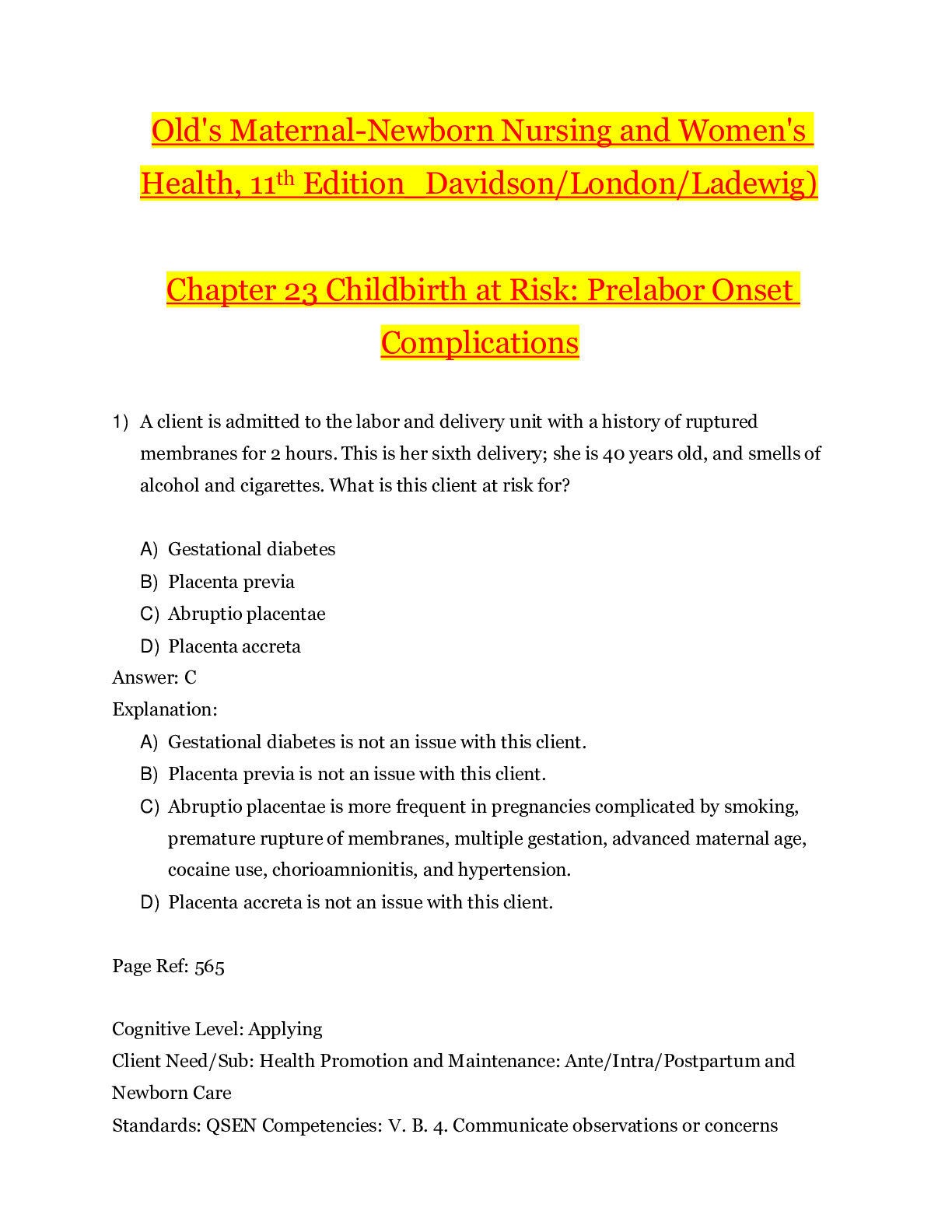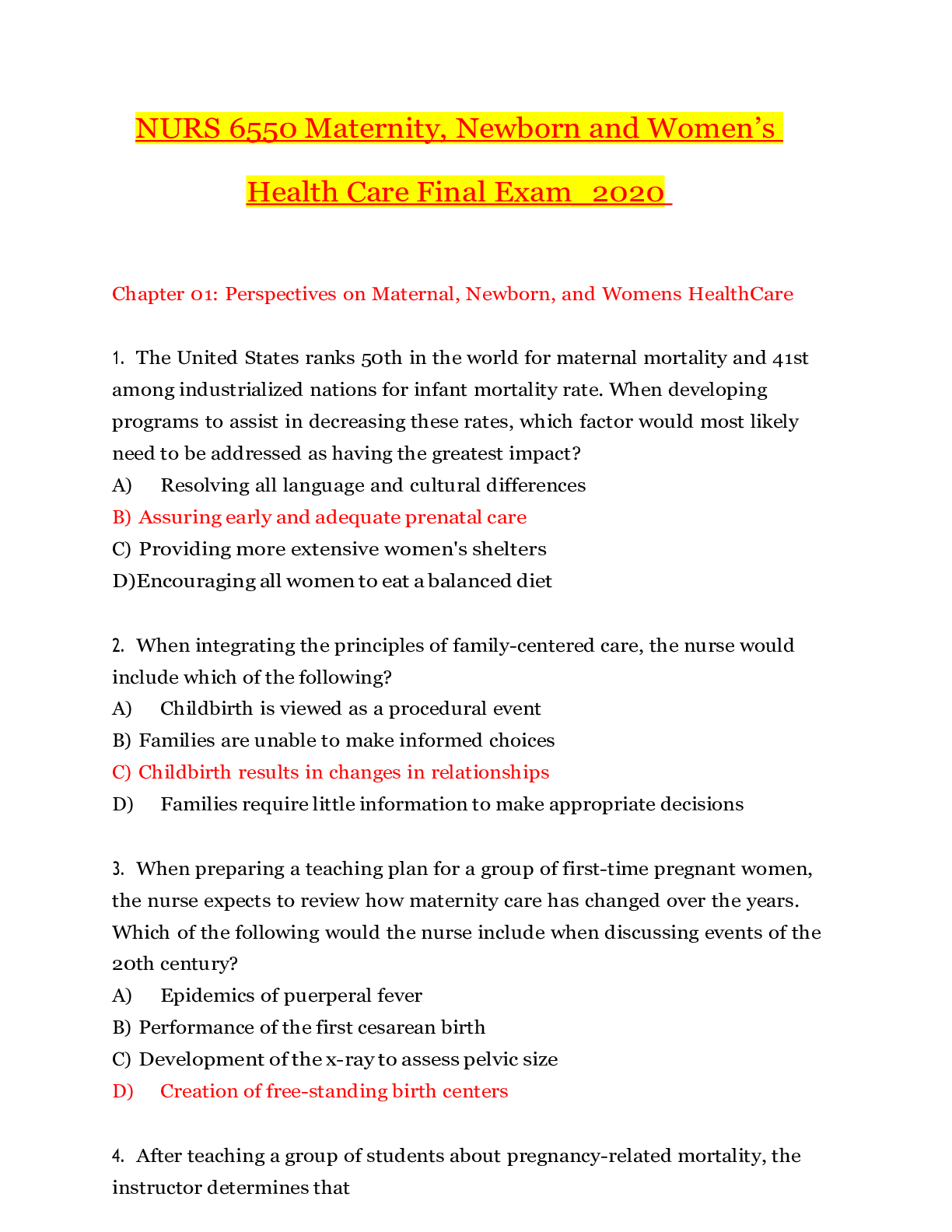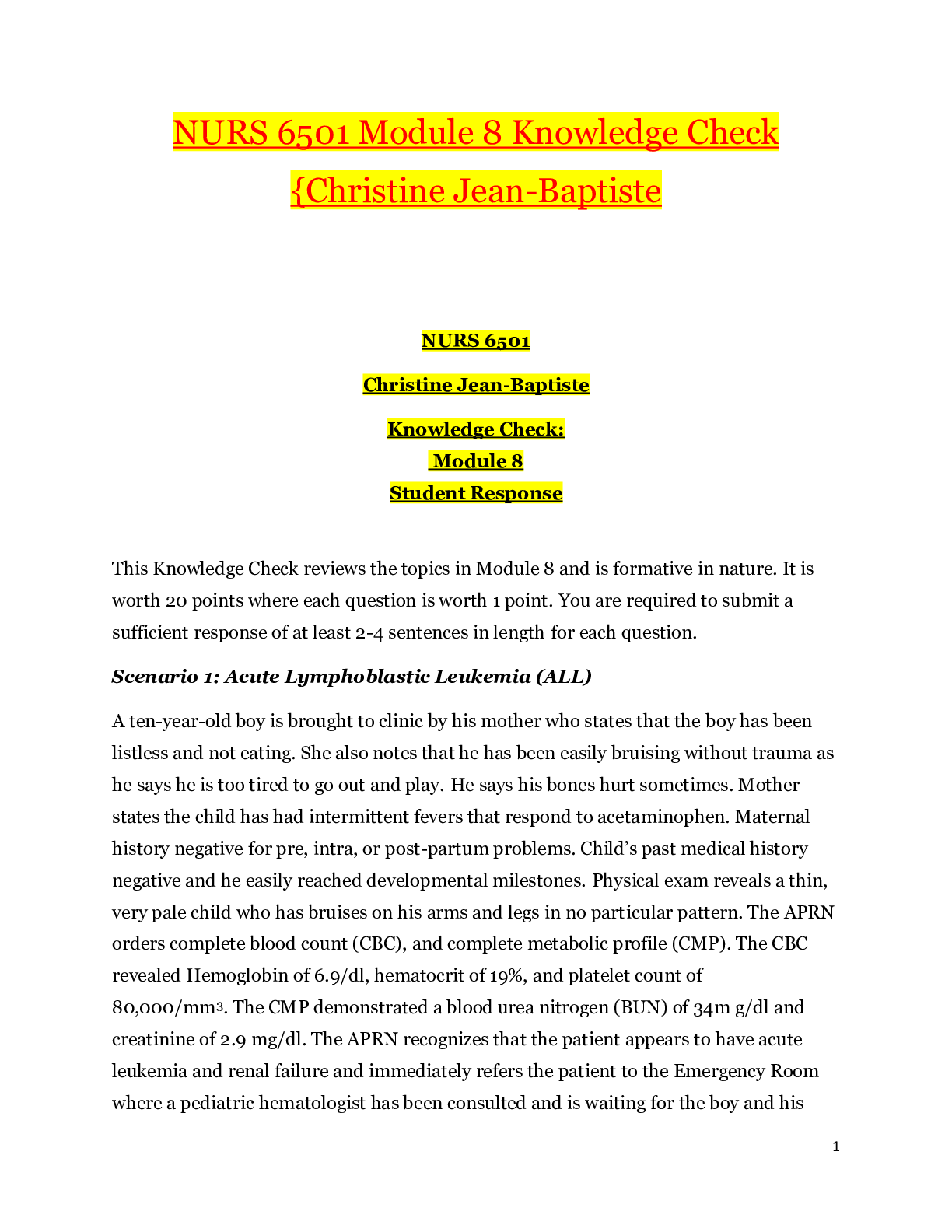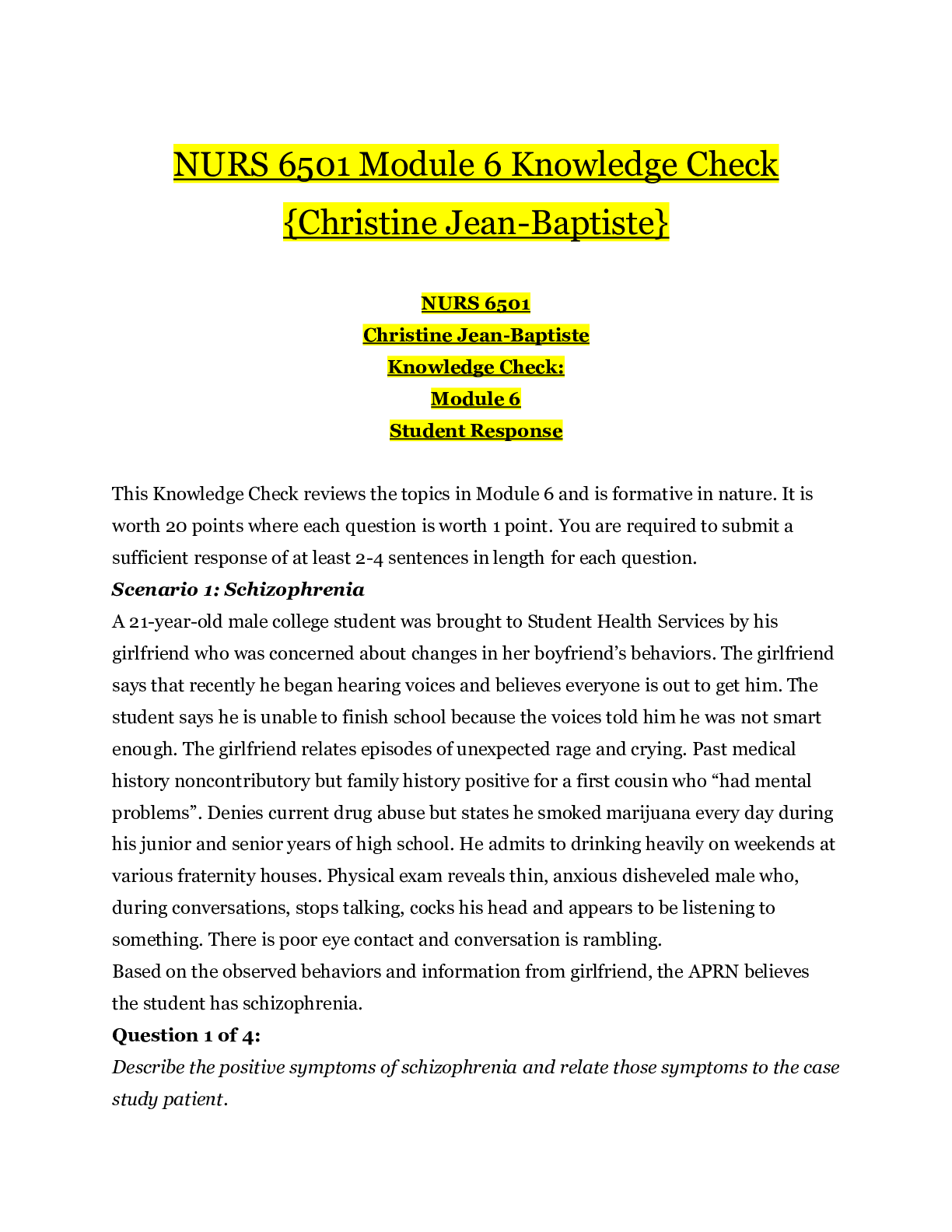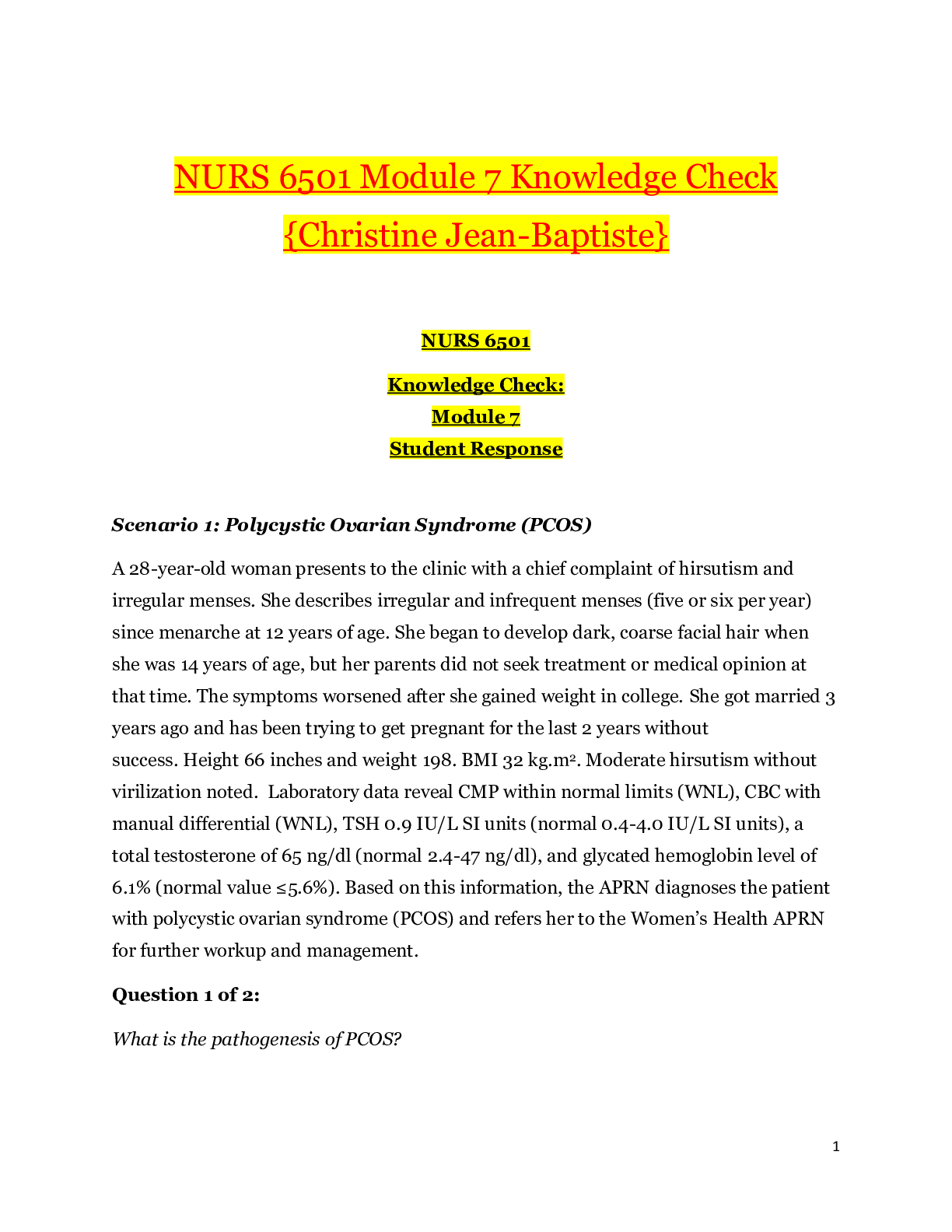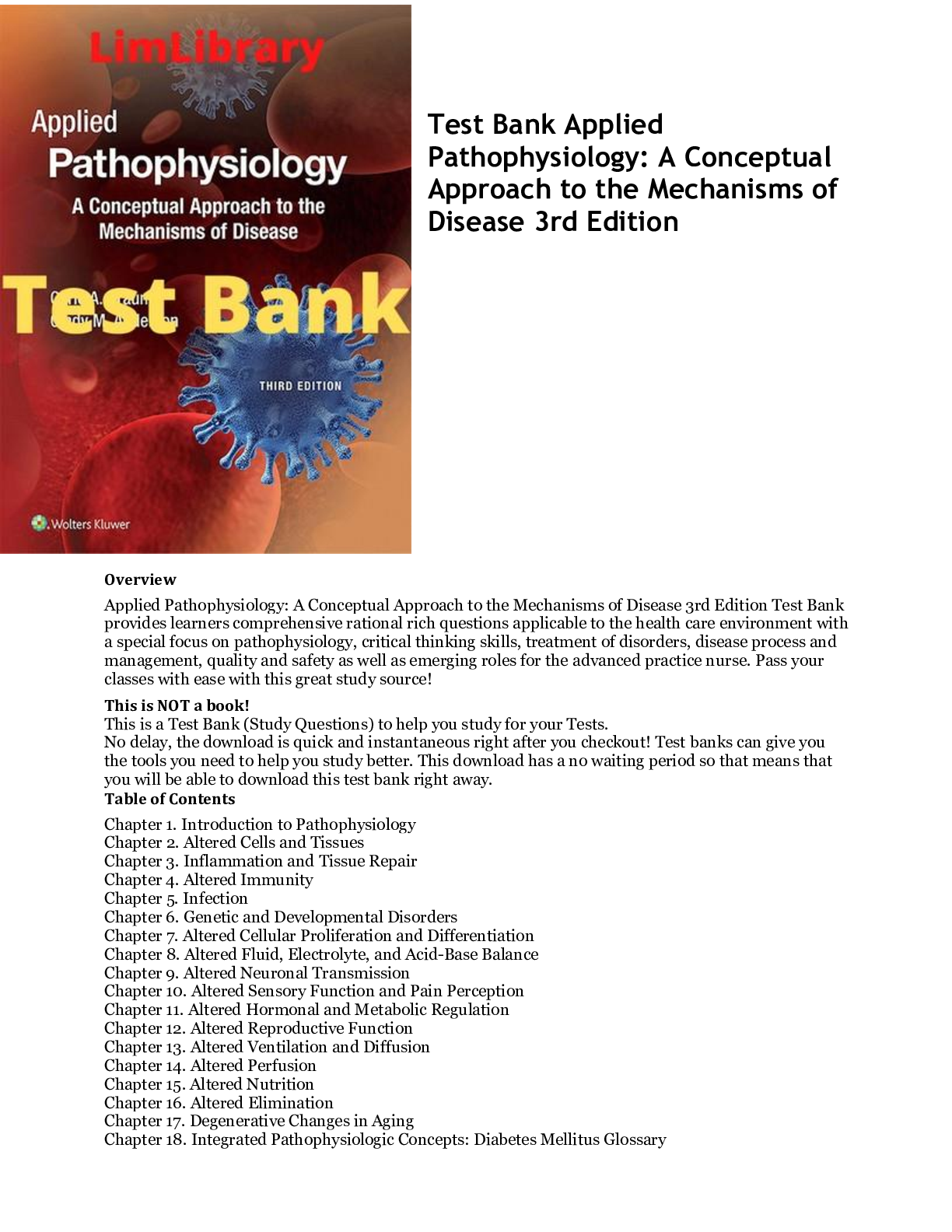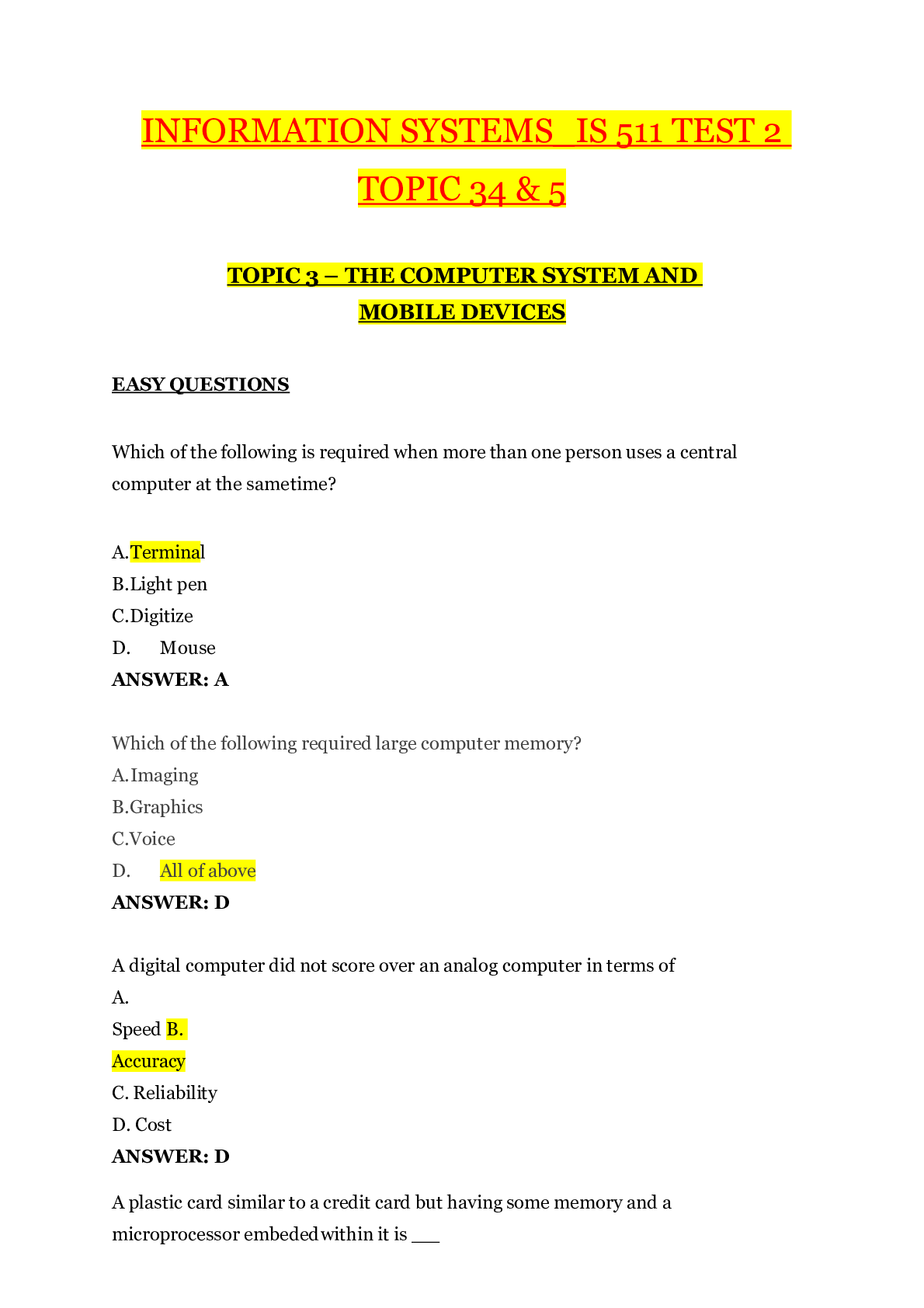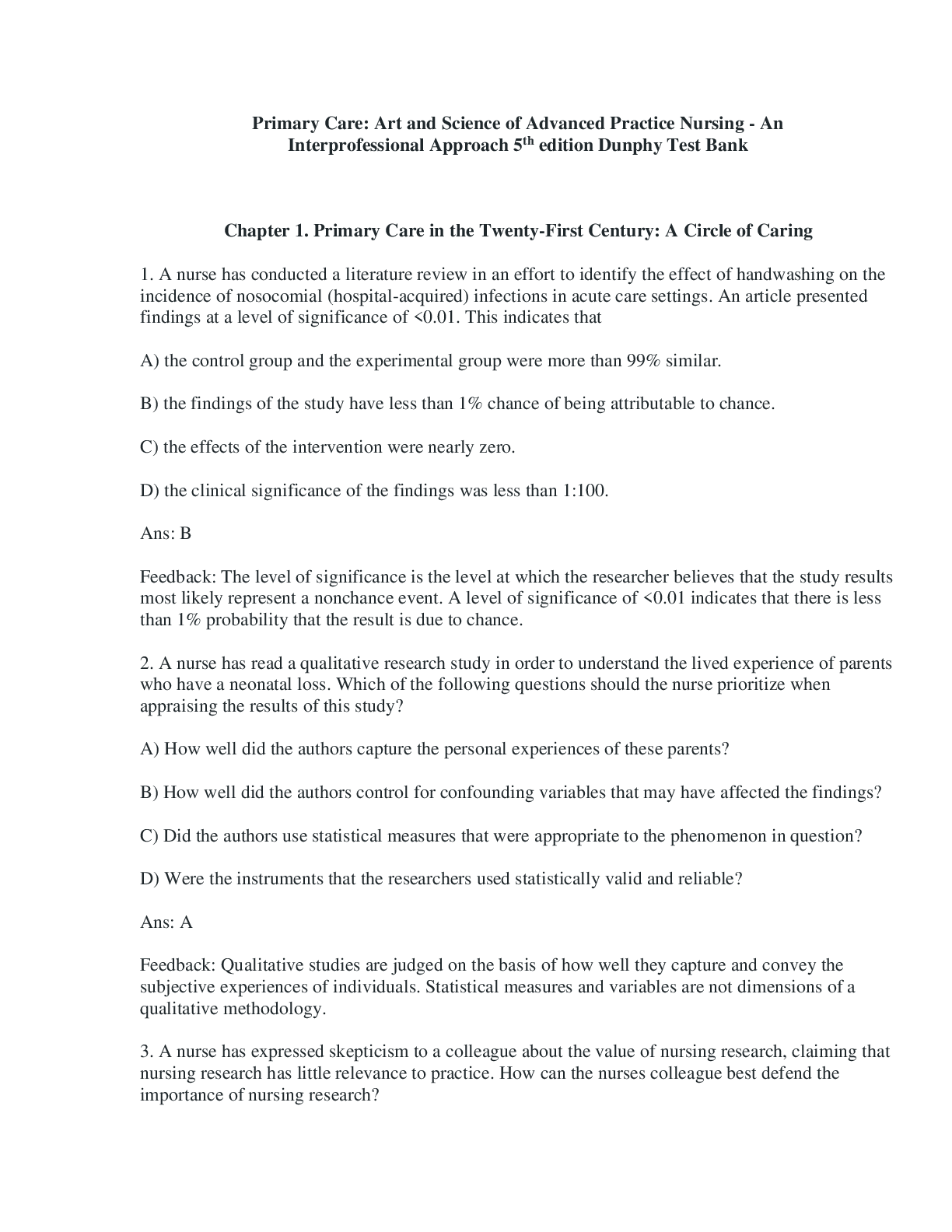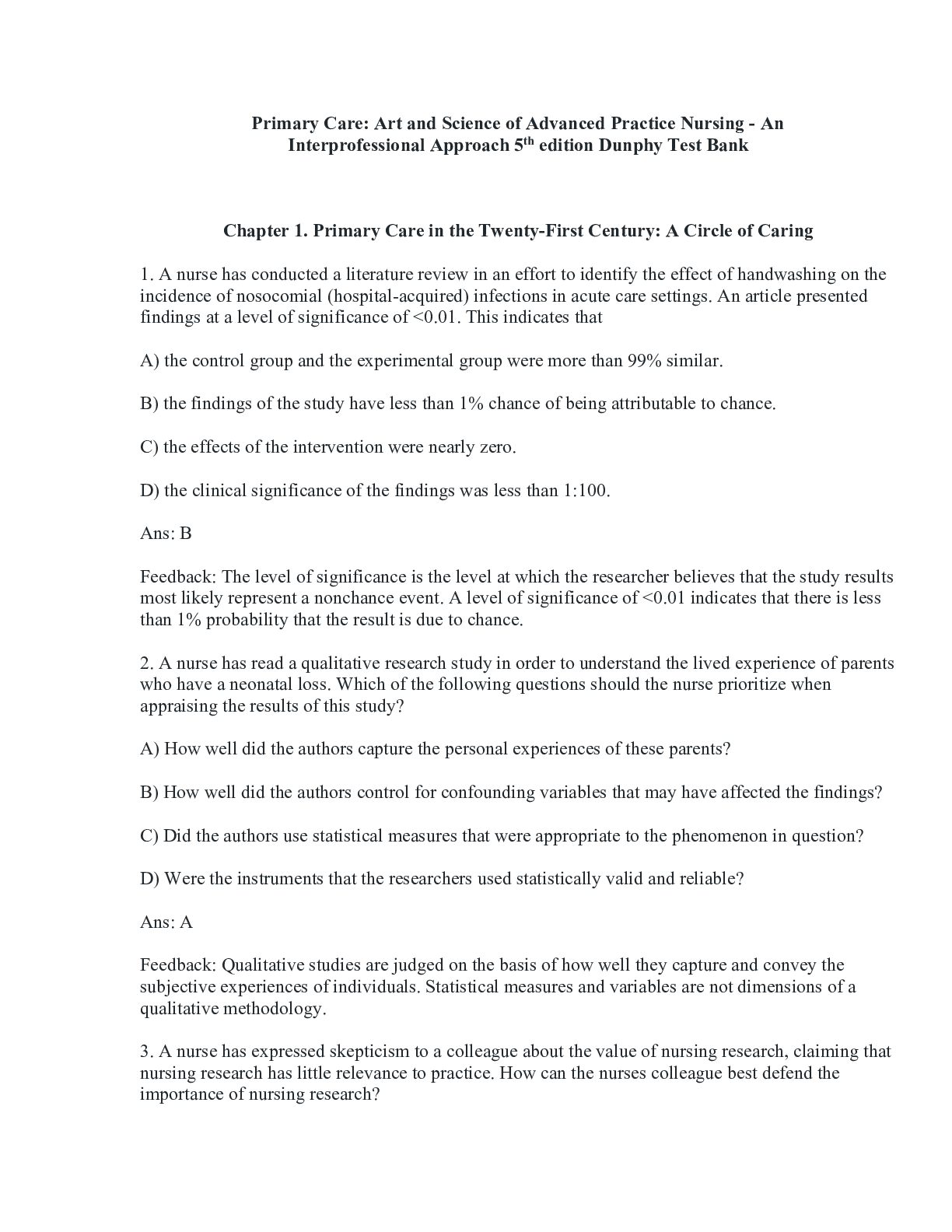Art and Science of Advanced Practice Nursing_2020
Document Content and Description Below
Chapter 3. Health Promotion MULTIPLE CHOICE 1. Which of the following is a primary prevention measure for a 76-year-old man newly diagnosed with a testosterone deficiency? A. Calcium supplementati... on B. Testicular self-examination C. Bone density test D. Digital rectal examination ANS: A PTS: 1 2. Which of the following is an example of secondary prevention in a 50-year-old woman? A. Yearly mammogram B. Low animal-fat diet C. Use of seat belt D. Daily application of sunscreen ANS: A PTS: 1 3. Which of the following is an example of tertiary prevention in a patient with chronic renal failure? A. Fluid restriction B. Hemodialysis 4 days a week C. High-protein diet D. Maintenance of blood pressure at 120/80 ANS: B PTS: 1 4. Immunizations are an example of which type of prevention? A. Primary B. Secondary C. Tertiary D. Quaternary ANS: A PTS: 1 5. The nurse is speaking to a patient regarding endemic diseases. Which of these choices describes an endemic statistic? A. The typical incidence of influenza in a country B. The surprise outbreak of malaria in new regions C. Higher levels of Ebola in a country when compared to the previous year D. Abnormal outbreak of measles in pockets of a country ANS: A PTS: 1 6. The nurse is reviewing old and current trends in disease history. Which of these would be considered an example of a sporadic outbreak?A. The number of people diagnosed with rabies virus in 2017 B. The number of people diagnosed with chlamydia in Texas over a 1-month period C. The number influenza cases diagnosed from 1918 to 1919 D. The number of common cold cases diagnosed in Washington between October 2016 and March 2017 ANS: A PTS: 1 7. Which accurately defines incidence rate? A. The number of old cases of a disease at a point in time B. The number of cases of a disease at a point in time divided by the percentage of the population at a point in time C. The number of total cases of a disease total diagnosed at a point in time D. The number of new cases of a disease diagnosed at a point in time ANS: D PTS: 1 8. What describes a pandemic? A. An event more than epidemic magnitude affecting a single community or country over a long period of time B. An event of epidemic magnitude affecting a single community or country in a short period of time C. An event of epidemic magnitude affecting multiple communities and countries in a short period of time D. An event less than epidemic magnitude affecting multiple communities and countries over a long period of time ANS: C PTS: 1 9. Which test of health literacy can be completed quickly and provide results comparable to more time-consuming tests? A. Test of Functional Health Literacy in Adults (TOFHLA) B. Patient Health Questionnaire (PHQ-9) C. Rapid Estimate of Adult Literacy in Medicine-Short Form (REALM-SF) D. Newest Vital Sign (NVS) ANS: D PTS: 1 10. The nurse is working with a 65-year-old patient who was recently diagnosed with hypertension. The patient is concerned about their optimal health with their new diagnosis. Which nursing action is necessary for health promotion with the patient? A. Discussing appropriate stress management techniques B. Sharing with the patient how to increase sodium consumption C. Discussing with the patient exercises that increase heart rate D. Emphasizing the importance of avoiding flu vaccinations ANS: A PTS: 1Chapter 5. Evidence-Based Care MULTIPLE CHOICE 1. What is the goal of nursing research? A. Make decisions regarding nursing education based on published literature B. Determine topics that could develop nursing knowledge C. Gather information from published literature to make decisions about application to clinical practice D. Conduct studies to develop a body of nursing knowledge ANS: D PTS: 1 2. Which is the most important question to ask in evidence-based practice? A. What findings constitute evidence? B. How will the findings be used? C. Is this a randomized controlled trial? D. What theory is being utilized? ANS: B PTS: 1 3. Nursing research should be utilized by: A. Nurses at the bedside B. Advanced practice nurses C. Nurse researchers D. Nurses at all levels of practice ANS: D PTS: 1 4. A clinical guideline may be found useful if the guideline was: A. Published 2 years ago B. Created using one group C. Authored by a relatively unknown source D. Funded by an anonymous source ANS: A PTS: 1 5. Practice guidelines are designed to: A. Be inflexible B. Be utilized in every circumstance C. Provide a reference point for decision making D. Be created by a professional organization to guide the practice of a profession ANS: C PTS: 1 6. Which of the following is an example of determining whether a crucial element of a guideline is applicable to your patients? A. There are no intended specific patients in the guideline.B. You are a primary-care provider and the guidelines were written for primary-care providers. C. Your patients have a much lower prevalence of a condition than the patients in the guideline. D. You are a pediatric oncologist and the guidelines were written for geriatric specialists. ANS: B PTS: 1 7. Which of the following would be considered the research design for Level I evidence? A. Single, well-designed, randomized clinical trial B. Systematic review of randomized clinical trial studies C. Well-designed controlled trials without randomization D. Systematic reviews of descriptive or qualitative studies ANS: B PTS: 1 8. Which of the following would be considered the research design for Level II evidence? A. Single descriptive or qualitative study B. Well-designed case control or cohort studies C. Single, well-designed, randomized clinical trial D. Systematic review of randomized clinical trial studies ANS: C PTS: 1 9. Which of the following would be considered the research design for Level III evidence? A. Well-designed controlled trials without randomization B. Systematic reviews of descriptive or qualitative studies C. Systematic review of randomized clinical trial studies D. Opinion of authorities and expert committees ANS: A PTS: 1 10. Which of the following would be considered the research design for Level IV evidence? A. Single descriptive or qualitative study B. Opinion of authorities and expert committees C. Systematic review of randomized clinical trial studies D. Well-designed controlled trials without randomization ANS: D PTS: 1 11. Which of the following would be considered the research design for Level V evidence? A. Systematic review of randomized clinical trial studies B. Well-designed controlled trials without randomization C. Systematic reviews of descriptive or qualitative studies D. Single descriptive or qualitative study ANS: C PTS: 1 12. Which of the following would be considered the research design for Level VI evidence?A. Systematic reviews of descriptive or qualitative studies B. Opinion of authorities and expert committees C. Well-designed case control or cohort studies D. Single descriptive or qualitative study ANS: C PTS: 1 13. Which of the following would be considered the research design for Level VII evidence? A. Well-designed controlled trials without randomization B. Opinion of authorities and expert committees C. Well-designed case control or cohort studies D. Single descriptive or qualitative study ANS: B PTS: 1 Section 1. Neurological Problems MULTIPLE CHOICE 1. Which statement about confusion is true? A. Confusion is a disease process. B. Confusion is always temporary. C. Age is a reliable predictor of confusion. D. Polypharmacy is a major contributor to confusion in older adults. ANS: D PTS: 1 2. Which of the following indicates a diagnosis of dementia? A. Onset after an infection B. Abrupt onset over a week C. Difficulty with long-term memory D. Hard time finding words ANS: D PTS: 1 3. Which of the following aspects of the patient history is a hallmark of delirium? A. Patient has chronic kidney disease. B. Patient has had aphasia for a year. C. Patient has diabetes mellitus. D. Patient has been getting lost driving home. ANS: A PTS: 1 4. Which of the following may trigger migraines? A. Taking an ibuprofen for muscle pain B. A cup of coffee with regular sweetener C. A glass of merlot wine D. Drinking a cup of green teaANS: C PTS: 1 5. Sondra’s peripheral vestibular disease causes dizziness and vertigo. Which of the following medications will help to decrease edema in the labyrinth of the ear? A. Meclizine B. Diphenhydramine C. Diamox D. Promethazine ANS: C PTS: 1 6. The hallmark of an absence seizure is: A. No activity at all B. A blank stare C. Urine is usually voided involuntarily D. The attack usually lasts several minutes ANS: B PTS: 1 7. Which of the following persons fits the classic description of a patient with multiple sclerosis (MS)? A. A teenage male B. A 65-year-old male C. A 25-year-old female D. A 60-year-old female ANS: C PTS: 1 8. Which of the following is a specific test to MS? A. Magnetic resonance imaging (MRI) B. Computed tomography (CT) scan C. A lumbar puncture D. There is no specific test ANS: D PTS: 1 9. Over the course of 3 years, a patient has had two MS flares. The patient’s primary complaints during the episodes are bilateral tingling and pain in their legs, depression, and numbness in their right hand with complete recovery in between occurrences. Which MS classification fits their disease process? A. Clinically isolated syndrome B. Relapsing-remitting C. Primary progressive D. Secondary progressive ANS: B PTS: 1 10. A patient with MS is complaining of new-onset “electric tingling” in both their arms. Which medication specifically treats these acute exacerbations? A. LemtradaB. Aubagio C. Zanaflex D. Depo-Medrol ANS: D PTS: 1 11. Which of the following is a risk factor for developing Alzheimer’s disease? A. Having a master’s or doctoral degree B. Patient is a physician C. Patient has Down’s syndrome D. History of neurological disease ANS: C PTS: 1 12. Which drug for Alzheimer’s disease should be administered beginning at the time of diagnosis? A. Cholinesterase inhibitors B. Anxiolytics C. Antidepressants D. Atypical antipsychotics ANS: A PTS: 1 13. The health-care provider is treating a patient who was hit in the head with a frying pan. Which of the following should the provider suspect? A. Intraparenchymal hemorrhage B. Subdural hematoma C. Epidural hematoma D. Subarachnoid hematoma ANS: B PTS: 1 14. Which hematoma occurs along the temporal cranial wall and results from tears in the middle meningeal artery? A. Epidural hematoma B. Subdural hematoma C. Subarachnoid hematoma D. Intraparenchymal hemorrhage ANS: A PTS: 1 15. Which of the following must be completed prior to administering TPA (tissue plasminogen activator)? A. Full-body MRI B. Head x-ray C. Head CT D. Head MRI ANS: C PTS: 116. Which cranial nerve is affected in a patient with a cerebrovascular accident who has difficulty chewing? A. CN V B. CN VII C. CN IX D. CN X ANS: A PTS: 1 17. Which of the following has been linked to a delay in treatment for stroke? A. Patient has stroke symptoms at work. B. Patient experiences stroke during the day. C. Patient lives with a family member. D. Patient calls their primary-care provider (PCP) instead of 911 at sign of stroke. ANS: D PTS: 1 18. When a patient has a carotid bruit, which of the following should the PCP gather from the patient history? A. History of hemophilia B. History of peripheral vascular occlusive disease C. History of seizure disorder D. History of sickle cell disease ANS: B PTS: 1 19. Which patient is more likely to have a cluster headache? A. A female in her reproductive years B. A 40-year-old African American male C. A 55-year-old female who drinks 10 cups of coffee daily D. A 45-year-old male awakened at night ANS: D PTS: 1 20. Which patient is most likely to have myasthenia gravis (MG)? A. A 75-year-old Caucasian woman B. A 31-year-old Hispanic woman C. A 55-year-old African American male D. A 10-year-old Middle Eastern male ANS: B PTS: 1 21. Inattention and a sleep–wake cycle disturbance are the hallmark symptoms of: A. Dementia B. Alzheimer’s disease C. Parkinson’s disease D. Delirium ANS: D PTS: 1 22. Which type of meningitis is more benign, self-limiting, and caused primarily by a virus?A. Purulent meningitis B. Chronic meningitis C. Aseptic meningitis D. Herpes meningitis ANS: C PTS: 1 23. A patient has been diagnosed with meningitis caused by a Streptococcus pneumoniae infection. Which of the following treatments would be appropriate? A. Cefotaxime B. Isoniazid C. Acyclovir D. Amphotericin ANS: A PTS: 1 24. Which of the following should be started promptly if viral encephalitis is suspected? A. Oral amoxicillin B. IV acyclovir C. IV ampicillin D. Oral acyclovir ANS: B PTS: 1 25. What is usually the first sign or symptom that a patient would present with that would make you suspect herpes zoster? A. A stabbing pain on one small area of the body B. A vesicular skin lesion on one side of the body C. A pain that is worse upon awakening D. A lesion on the exterior ear canal ANS: B PTS: 1 26. Which patient is most likely to be diagnosed with Guillain-Barré syndrome? A. A 6-month-old infant B. A 30-year-old man C. A 72-year-old woman D. A 50-year-old man ANS: C PTS: 1 27. Gabby, aged 22, has Bell’s palsy on the right side of her face. Her mouth is distorted, and she is concerned about permanent paralysis and pain. What do you tell her? A. “Most patients have complete recovery in 3 to 6 months.” B. “Unfortunately, you’ll probably have a small amount of residual damage.” C. “Don’t worry, I’ll take care of everything.” D. “You may have a few more episodes over the course of your lifetime but no permanent damage.” ANS: A PTS: 128. A patient is presenting with chorea (dance-like movements). Which of the following diseases might the patient have? A. Dementia B. Parkinson’s disease C. Wilson’s disease D. Huntington’s disease ANS: D PTS: 1 29. Which of the following signs would a health-care provider expect to see in a patient with Parkinson-plus disorder? A. Resting tremor B. Bradykinesia C. Rigidity D. Postural instability ANS: D PTS: 1 30. Which of the following is a sign or symptom of a migraine? A. Light sensitivity B. Nonpulsatile pain C. Nasal stuffiness D. Bandlike pain ANS: A PTS: 1 31. Carotid endarterectomy should be considered only for symptomatic patients with greater than what percentage of stenosis? A. Greater than 25% B. Greater than 50% C. Greater than 75% D. Only for 100% occlusion ANS: B PTS: 1 32. Which of the following activities is part of the functional activities questionnaire? A. Asking the patient to unravel a Rubik’s cube B. Determining if the patient can drive on the highway C. Asking the patient about a news event from the current week D. Seeing if the patient can keep his or her home clean ANS: C PTS: 1 33. About 90% of all headaches are: A. Tension B. Migraine C. Cluster D. Without pathological cause ANS: D PTS: 134. Which statement is true regarding driving and patients with a seizure disorder? A. Once diagnosed with a seizure disorder, patients must never drive again. B. After being seizure free for 6 months, patients may drive. C. Each state has different laws governing driving for individuals with a seizure disorder. D. These persons may drive but never alone. ANS: C PTS: 1 35. Julie has relapsing-remitting muscular sclerosis. She has not had a good response to interferon. Which medication might help given IV once a month? A. Glatiramer acetate B. Natalizumab C. Fingolimod D. Glucocorticoids ANS: B PTS: 1 36. The “freezing phenomenon” is a cardinal feature of: A. Parkinson’s disease B. Alzheimer’s disease C. A cerebrovascular accident (CVA) D. Bell’s palsy ANS: A PTS: 1 37. A ratchet-like rhythmic contraction, especially in the hand, during passive stretching is known as: A. Spinothalamic dysfunction B. Ratcheting C. Cogwheeling D. Hand tremors ANS: C PTS: 1 38. Which condition is characterized by the impaired ability to learn new information along with a cognitive disturbance in either language, function, or perception? A. Guillain-Barré syndrome B. Parkinson’s disease C. Alzheimer’s disease D. Delirium ANS: C PTS: 1 39. A score of 12 to 24 on this test indicates intermediate Alzheimer’s disease: A. SLUMS B. MoCA C. FAST D. MMSE ANS: D PTS: 140. IV thrombolytic therapy following an ischemic CVA should be given within how many hours of symptom onset? A. 1 hour B. 3 hours C. 6 hours D. 12 hours ANS: B PTS: 1 41. When administered at the beginning of an attack, oxygen therapy may help this kind of headache? A. Tension B. Migraine C. Cluster D. Stress ANS: [Show More]
Last updated: 1 year ago
Preview 1 out of 146 pages
Instant download

Buy this document to get the full access instantly
Instant Download Access after purchase
Add to cartInstant download
Reviews( 0 )
Document information
Connected school, study & course
About the document
Uploaded On
Mar 26, 2021
Number of pages
146
Written in
Additional information
This document has been written for:
Uploaded
Mar 26, 2021
Downloads
0
Views
27

.png)


